Wine Lister has produced its second in-depth regional study, this time on Tuscany – a many-faceted fine wine region that is fast-building its position on the global fine wine stage. We will be revealing some of the findings on the blog in the next few weeks, but the full 35-page report is available for subscribers on the Analysis page.
The study focuses on 50 top Tuscan wines, which we have compared below with 50 wines from Piedmont, Bordeaux, Burgundy, and California. Using the three categories that comprise an overall Wine Lister score – Quality, Brand, and Economics – we can put the region’s global positioning in context.
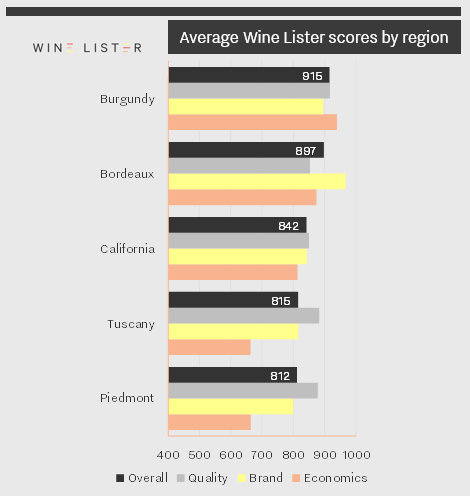
Although Tuscany comes fourth overall – just ahead of Piedmont – its Quality score is bettered only by Burgundy, scoring 883 points to Burgundy’s 917. Quality scores are derived from Wine Lister’s partner critics’ scores and a wine’s ageing potential, and Tuscany’s excellence in this category may be one explanation for its rising appeal.
Tuscany’s Brand score is the fourth best of the group, suggesting that after a handful of top brands such as the Super Tuscans, the rest of the top 50 do not confer the same level of prestige as wines in Bordeaux, Burgundy, or even California. Meanwhile, the region’s commercial clout is the weakest of the group, scoring one point less than Piedmont in the Economics category.
In upcoming posts, we will delve into the trade’s view on Tuscany’s foremost appellations and which are the wines to watch.
“Which producers will see the largest gain in brand recognition in the next two years?” That was one of the questions Wine Lister asked its Founding Members, in its latest survey of 49 of the world’s key wine trade players, between them representing well over one third of global fine wine revenues.
Continue Reading →
This morning sees the ex-château release of Latour 2005, along with second wine, Les Forts de Latour 2011. We have put together two factsheets bringing together all the most important information about these two formidable wines, both approaching their drinking windows.
The 2005 Grand Vin has the third-highest Wine Lister Quality score of the last three decades, and looks reasonable value next to the 2009 and 2010:
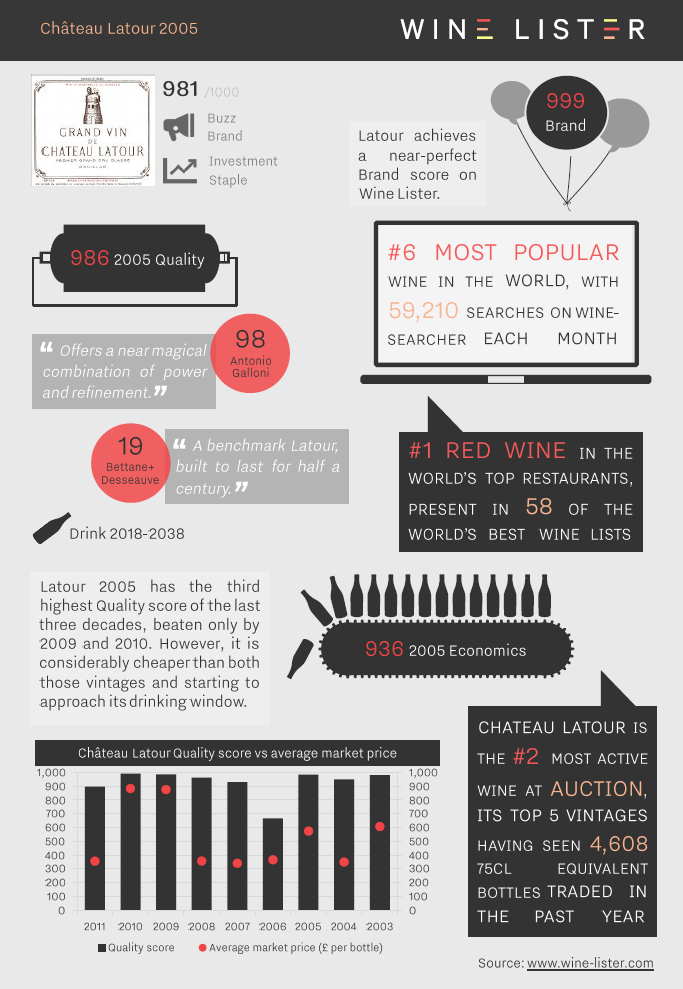
The 2011 vintage of Château Latour’s second wine, Les Forts de Latour, is an economic powerhouse, with impressive price growth since its release:
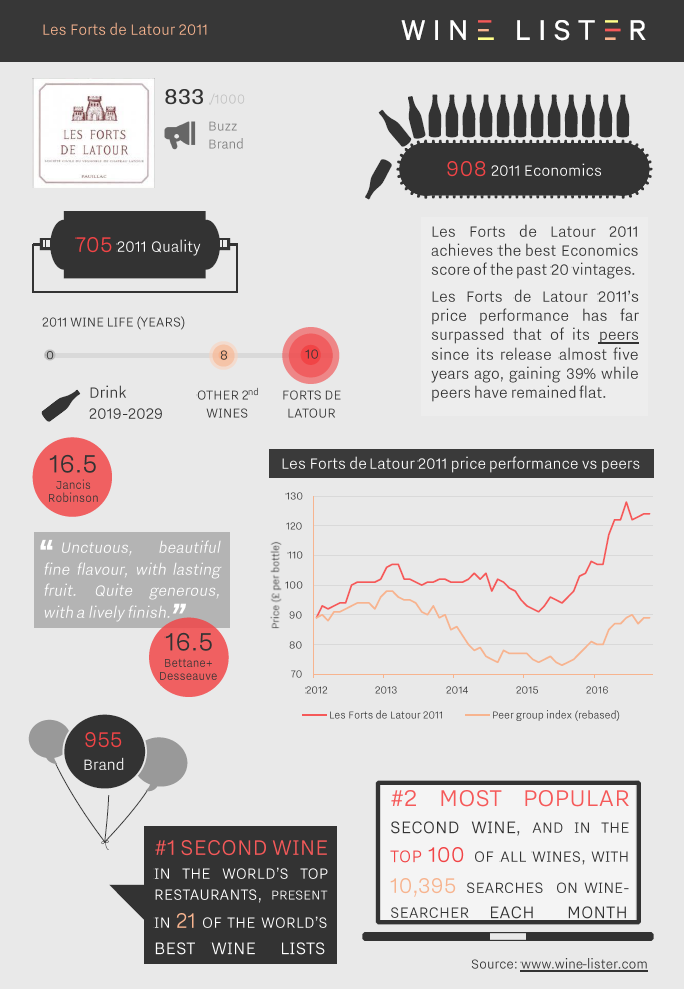
You can download the slides here: Wine Lister Factsheet Latour 2005 / Wine Lister Factsheet Les Forts de Latour 2011
Measuring the number of searches on the world’s most visited wine site, Wine-Searcher, provides a unique insight into an individual wine’s overall popularity. Following on from last week’s blog on wine searches we have aggregated two years’ worth of this data at region level, to put popularity in perspective and map fine wine market trends over time.
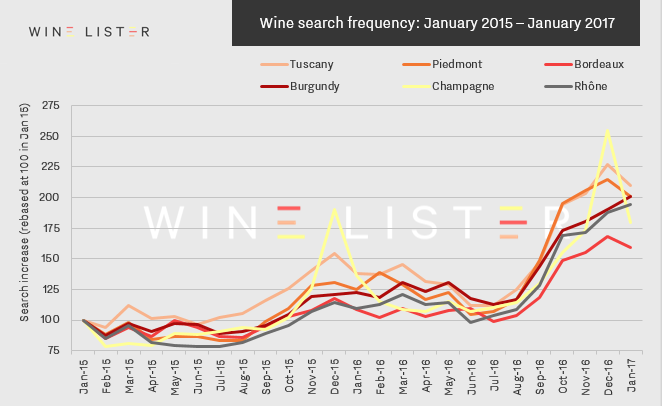
Above, we have taken the 50 most searched-for wines from the leading fine wine regions in France and Italy and tracked their changes in search frequency over two years. Despite natural peaks and troughs – including large spikes for Champagne during the festive season – the last six months show an acceleration in searches for wines of every region.
Several wine regions have seen searches more than double in the last two years, with Tuscany, Piedmont and Burgundy as the stand-out performers. Meanwhile, Bordeaux – the most searched-for region in real terms – has struggled to engage new audiences at the same rate as its counterparts. For more on Tuscany’s rising global clout, see our in-depth regional study, available to subscribers on the Analysis page.
To view the popularity of individual wines, simply search for your wine of choice on Wine Lister and explore the Brand score sub-criteria.
The latest development on wine-lister.com enables you to see the four most interesting nuggets of information about more than 2,000 of the world’s finest wines at a single glance. Simply search for and click on the wine you want to explore, such as Yquem or Ornellaia, and scroll down to Data Driven Analytics.
An algorithm sifts through Wine Lister’s vast database, asking 37 different types of question for each wine in order to identify its most remarkable facts. These are split into four groups: first production data, and then each of the three Wine Lister rating categories – Quality, Brand, and Economics.
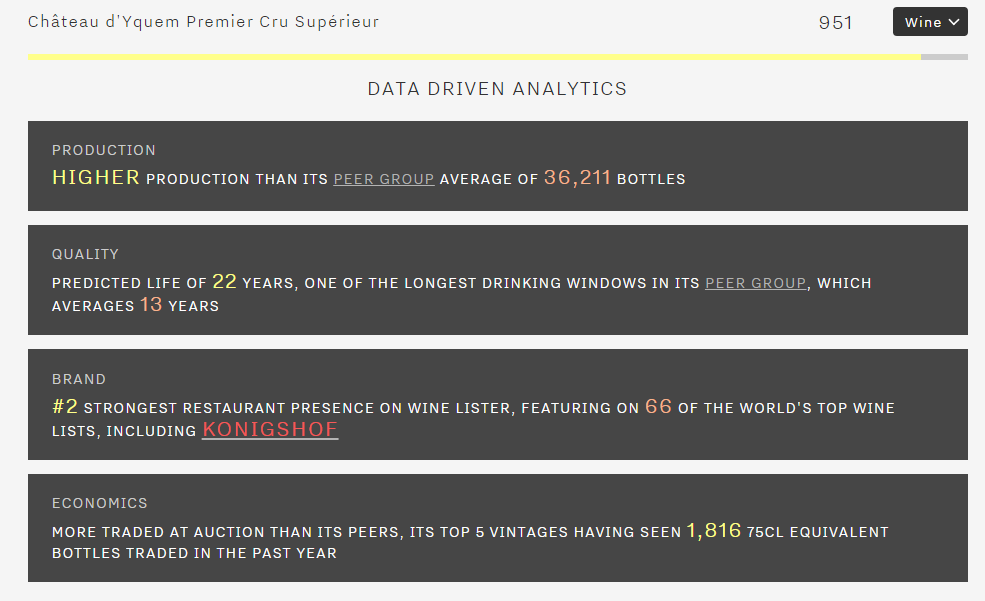
The range of questions asked produces different data nuggets for each wine. For example, the Quality analytics for Château d’Yquem references its longevity, whereas for Tenuta dell’Ornellaia the result relates to the average critics’ score.
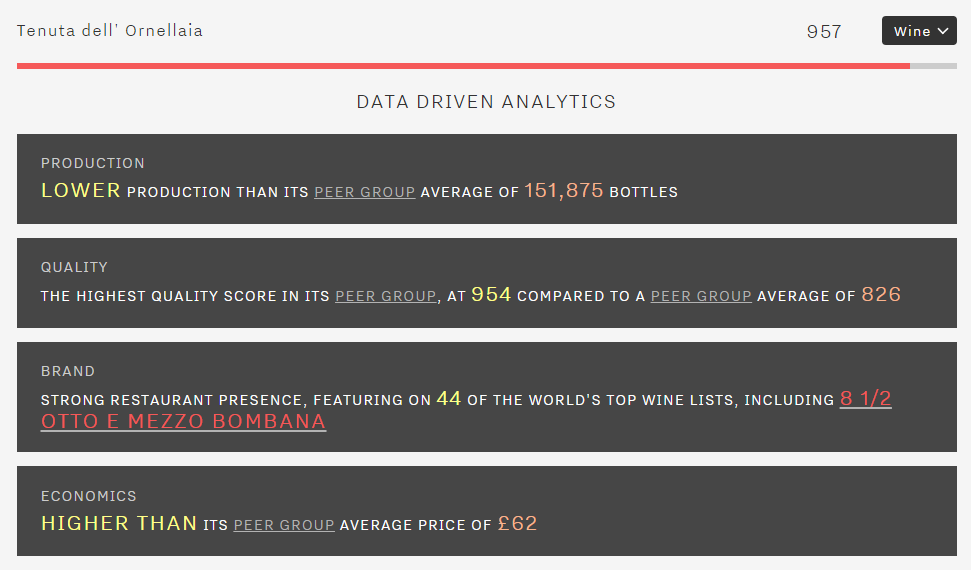
Explore this feature at wine-lister.com (and look up the most remarkable facts on one of your favourite wines, or see if you can find the top three most sought-after wines, for example).
Yesterday saw the release of the latest vintage of Sassicaia, the challenging 2014 vintage. None of our partner critics has yet tasted scored the wine in bottle, but Vinous’s Antonio Galloni found the wine “promising” from barrel (read more here).
Wine Lister’s CEO, Ella Lister, recently attended a 44-vintage tasting of Sassicaia in Rome, beginning with its first commercial release, 1968. “This once-in-a-lifetime tasting proved the amazing consistency of the wines’ quality as well as their extraordinary ageing capacity”, she reported.
In the context of this release, we explore the whole gamut of vital facts about Sassicaia, a formidable wine regardless of the vintage:
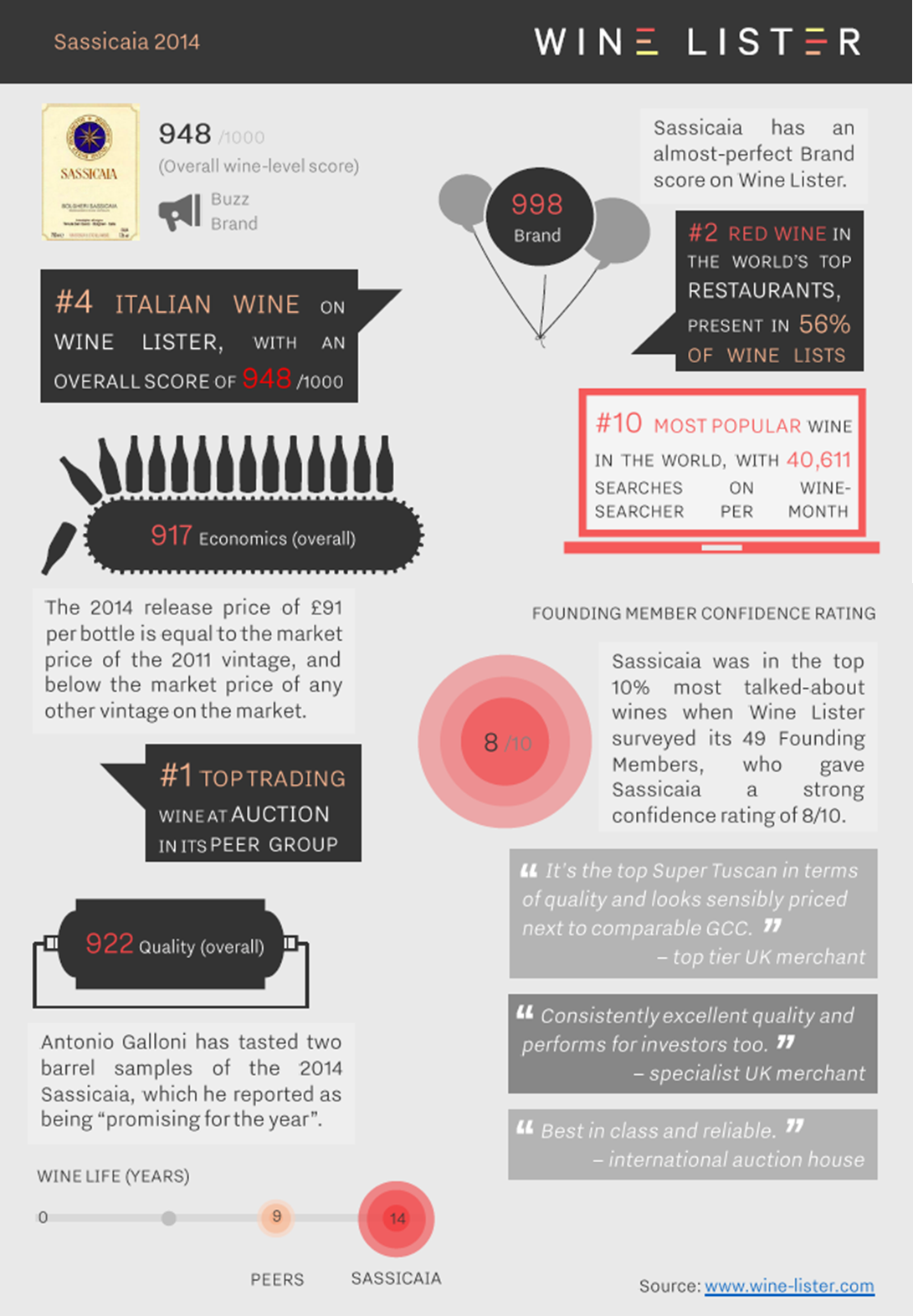
You can download the slide here: wine-lister-factsheet-sassicaia-2014
As we know, the quality of a wine is not set in stone. Just like our Brand and Economics scores, Wine Lister’s Quality scores are also updated over time as wines evolve and new vintages are released.
Our algorithm analyses Quality by aggregating ratings from our three partner critics: Jancis Robinson, Bettane+Desseauve and Vinous (Antonio Galloni). It also comprises a small weighting for a wine’s longevity, based on the critics’ combined drinking windows, with the drink-by date updated regularly as our partner critics retaste and reevaluate.
In this post we look at the 10 biggest gainers in Quality over the course of 2016:
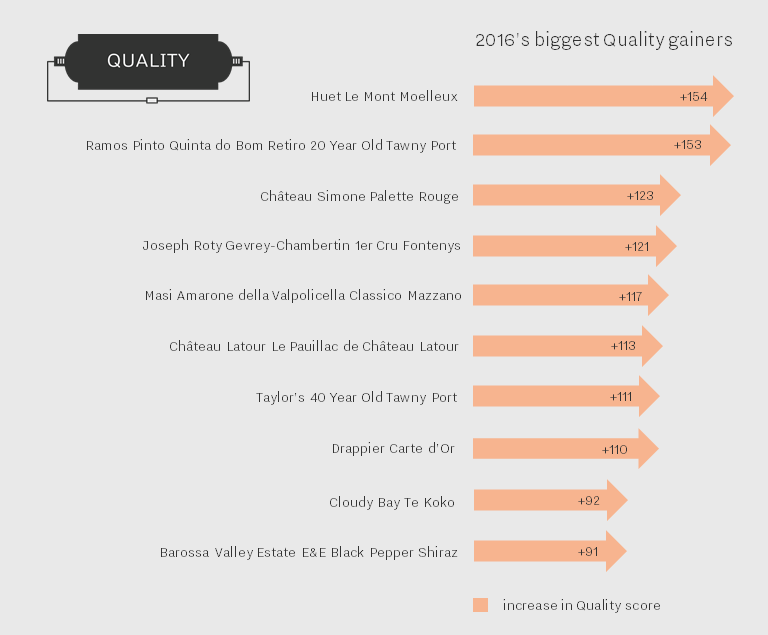
Huet’s Le Mont Moelleux improved the most last year, adding over 20% to its score, taking it to 917. This is down to a score of 18/20 for the 2015 vintage from our UK partner critic JancisRobinson.com.
Also partly thanks to a new score of 18 from the same critic, in second place is the fortified Ramos Pinto Quinta do Bom Retiro 20 Year Old Tawny Port. The wine was also deemed to be eight years longer-lived than had been previously thought, contributing considerably to its Quality score surge.
Château Simone’s Palette Rouge received a higher-than-average score from Bettane+Desseauve for its 2012 vintage, making it the third-highest gainer for the year.
Improvements were also enjoyed across a wide range of other regions, from Bordeaux to Champagne, and in the New World.
Who will be 2017’s biggest Quality gainers? Only time (and tastings) will tell.
Here’s the latest instalment of our monthly series on biggest Brand gainers.
The latest Wine-Searcher search frequency data is in, allowing us to update our Brand scores with changes to each wine’s popularity (one of the two criteria contributing to the Wine Lister Brand score, the other being a wine’s presence in the world’s top restaurants).
The chart below gives us a breakdown of the five wines which improved their Wine Lister Brand score most during December:
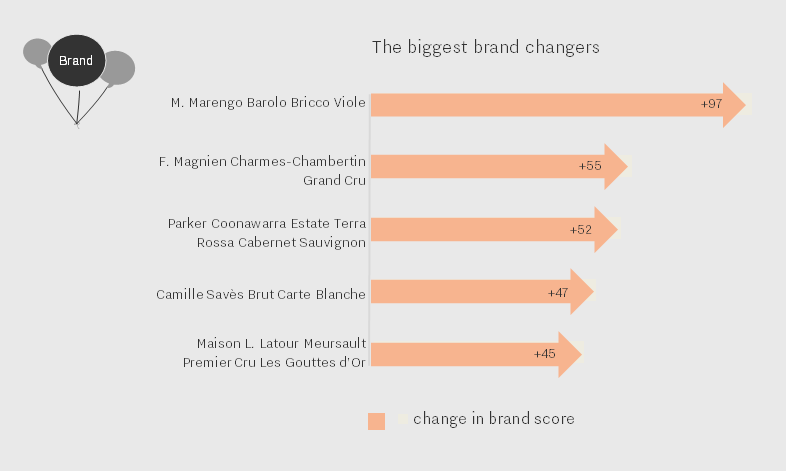
The top five Brand gainers are not concentrated in any one country or region, with Italy, Australia, and three different French regions all represented.
As in November, Barolo is again represented. With a percentage increase of 28% in Brand score, Marengo’s Barolo Bricco Viole saw a surge in monthly online searches, increasing from an average of 103 to 342.
The second biggest gainer is Magnien’s Charmes-Chambertin Grand Cru, whose average monthly searches have doubled, helping raise its overall Brand score above the Wine Lister average to 545/1000.
We’ll be back next month with an update on January’s biggest Brand changers.
We’re always adding new features to Wine Lister, and in direct response to your feedback, we are pleased to introduce our new wine comparison tool. Released late in 2016 (it wasn’t all bad!), this is a valuable, visual device for comparing up to three wines of your choice.
Whether you want to look at three vintages of the same iconic wine, three cuvées from the same producer or three completely different wines, our comparison tool allows for an instant side-by-side analysis of each of the 11 criteria (across three main categories) that make up Wine Lister’s overall score.
Let’s look at it in practice. Below you will see Domaine du Comte Liger-Belair’s Vosne-Romanée Premier Cru Les Suchots:
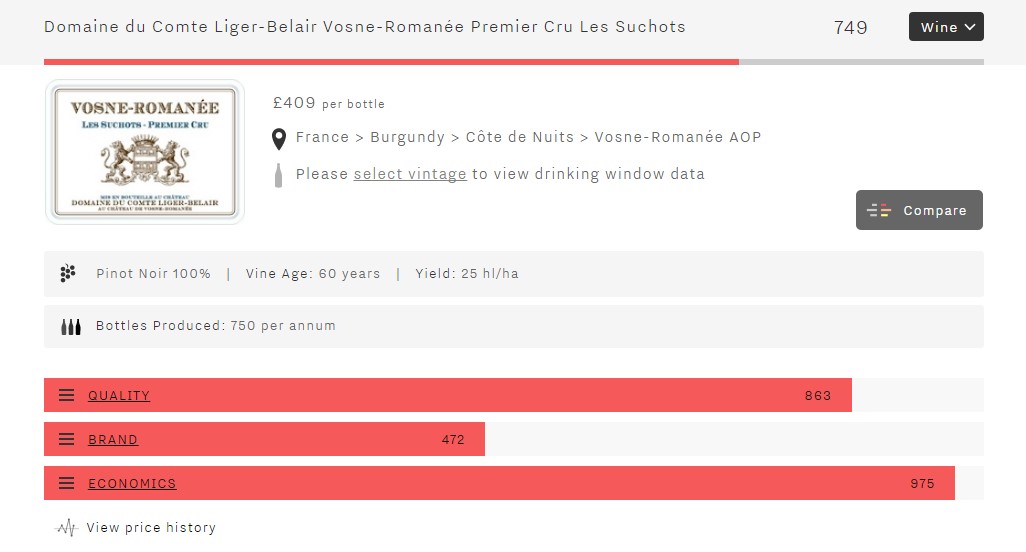
By simply clicking “Compare“, you can add up to two more wines to the analysis:
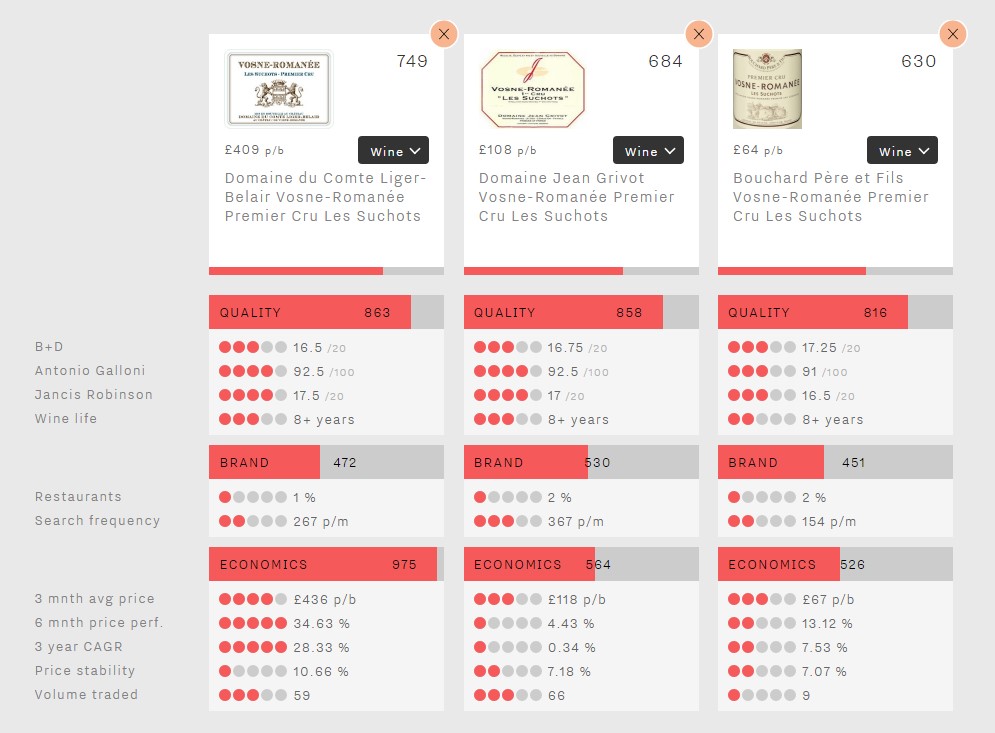
In this instance, we have chosen to analyse three different producers’ wines from the lieu-dit of Les Suchots in Vosne-Romanée, at wine-level rather than in a specific vintage. We can quickly see that these three Les Suchots wines score similarly well in Quality, but in Brand and Economics there are greater differences. Grivot’s Les Suchots scores highest in Brand, while that from Bouchard scores lowest. It is the outstanding Economics score from Comte Liger-Belair’s example that brings it out on top in the overall Wine Lister score.
In-depth wine comparison has never been quicker or easier! Try it for yourself (subscription or free trial required).
The graph below shows the average long term price performance of top scoring Wine Lister wines by country, and the USA bucks the trend of elites on top (with an early congratulatory nod from France).
We have split out performance for an elite group of the 15 highest-scoring wines, and compared this to performance for a wider panel of 50 wines. For the majority of countries, the elite wines – let’s call them the establishment – have seen their stock rise over the last three years.
In the USA, it is the broader-based group (the red column) that has trumped the establishment (gaining more than 9%). The same is true in France, where a broader group of wines has penned a tale of higher returns.
Our measure of long term price performance is the 3 year compound annual growth rate (CAGR) which facilitates comparison to other investment products.
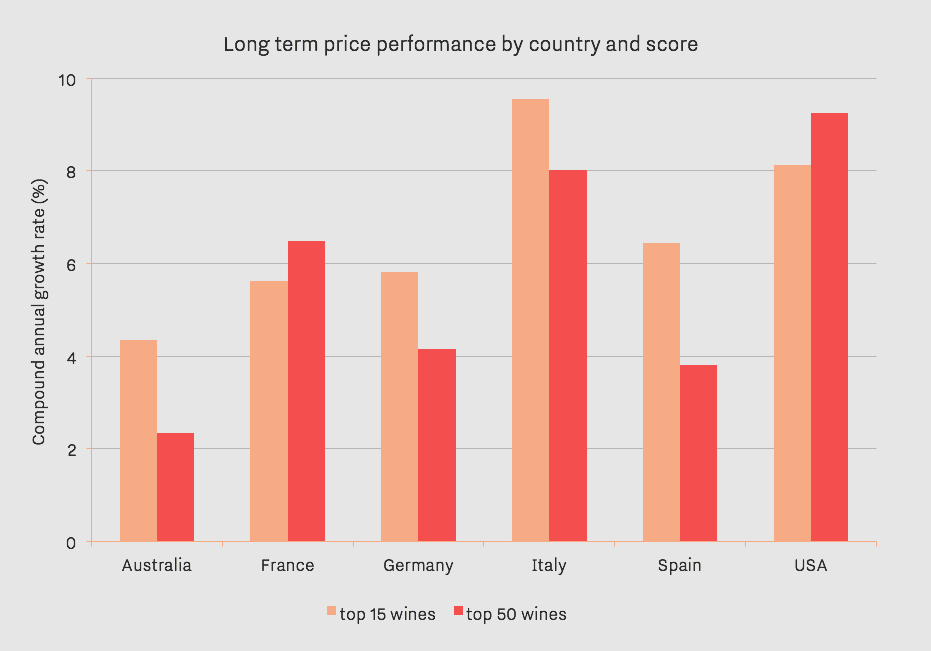
Elsewhere, Italian wines have seen the best returns among their elite group, averaging annual price gains of almost 10% – the most impressive of any group analysed here. One of the top performing wines in Italy’s top 15 scorers is Bartolo Mascarello’s Barolo (of “no barrique, no Berlusconi” fame), whose average (cross-vintage) price performance is 23% CAGR over the last 3 years.
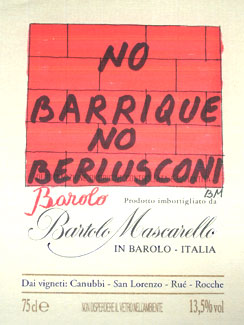
The elites also outperform the up-and-comers in Spain, Germany, and Australia, perhaps explained by the fact that there are fewer really well established top-end brands in these countries compared to France, and so their respective top 50 groups are less entrenched, and their top 15 groups still have room to grow in recognition and price.












